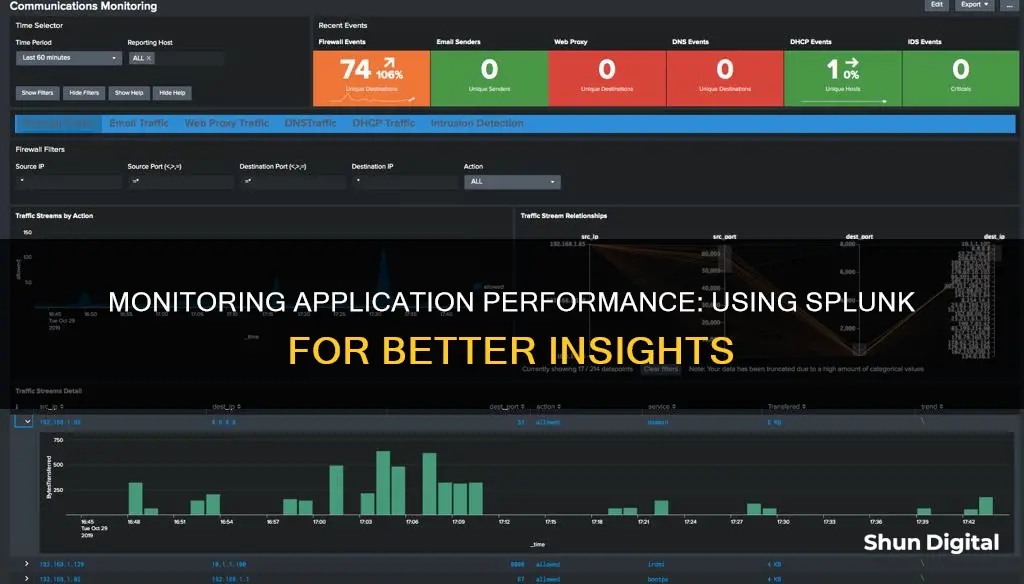
Monitoring application performance is crucial for business success and customer satisfaction. Application Performance Monitoring (APM) is a technology that provides real-time information about how software applications are performing. APM technology ensures that all services are available with minimal downtime, so that customers and internal employees have a positive experience. APM systems aggregate performance data from different parts of the application into a dashboard, where you can view performance metrics and set thresholds for each metric, triggering alerts when needed. APM tools also capture traces and logs, which help to identify the root cause of performance issues. Synthetic monitoring, a feature of APM, simulates user interactions to test the application's performance, helping to detect problems like broken links and slow page load times. APM brings a range of benefits, including proactive problem resolution, enhanced user experience, optimized resource allocation, and data-driven decision-making.
| Characteristics | Values |
|---|---|
| Purpose | Monitor application performance to ensure minimal downtime and a positive experience for customers, internal employees, and stakeholders |
| Function | Provides real-time information about how software applications are performing |
| Benefits | Proactive problem resolution, enhanced user experience, optimized resource allocation, data-driven decision-making, monitoring of Service Level Agreements (SLAs), and support for business outcomes |
| Data Collection | Instrumentation and agents, traces and logs, agentless monitoring, synthetic monitoring |
| Data Analysis | AI-guided insights, full-context troubleshooting, end-to-end visibility, database query monitoring, alerting on slow response times or problematic queries |
| Use Cases | On-premises application monitoring, cloud-native application monitoring, microservice monitoring |
What You'll Learn

Monitor CPU and memory consumption
Monitoring CPU and memory consumption is crucial for maintaining optimal application performance. Here are some detailed instructions on how to achieve this using Splunk:
Utilise Splunk APM
Splunk Application Performance Monitoring (APM) is a powerful tool for monitoring CPU and memory consumption. It provides end-to-end visibility, allowing you to troubleshoot complex environments faster. With Splunk APM, you can continuously monitor CPU and memory consumption of code written in Java, .NET, and Node.js with built-in code profiling. This helps you identify issues impacting important business KPIs and accelerate resolution times.
Use Dashboards and Reports
Splunk offers various dashboards and reports that provide insights into CPU and memory usage. The Performance Monitoring page in Splunk App for Windows Infrastructure includes dashboards for CPU, memory, disk, network interface, and system metrics. You can customise the data displayed by selecting specific counters and instances. Additionally, you can drill down into specific host, process, and user details for memory, CPU, disk, and network traffic. Utilise the provided reports as a guide to create custom reports tailored to your needs.
Track Memory and CPU Usage
To track memory and CPU usage per search execution, you can use the following search query:
Index=_introspection host=* source=*/resource_usage.log* component=PerProcess data.process_type="search" | stats latest(data.pct_cpu) AS resource_usage_cpu latest(data.mem_used) AS resource_usage_mem by data.pid, _time, data.search_props.type,data.search_props.mode, data.search_props.role,data.search_props.user, data.search_props.app, data.search_props.sid
This query helps you monitor CPU and memory utilisation, providing details such as the process ID, time, search properties, and resource usage.
Alerts for Splunk Admins
SplunkBase Developers Documentation suggests exploring dashboards in Alerts for Splunk Admins (splunkbase) or on GitHub to track memory and CPU usage. Dashboards like troubleshooting_indexer_cpu, troubleshooting_resource_usage_per_user, and detect_excessive_search_use can assist in identifying issues related to resource usage and search execution.
Best Places to Buy Alienware Monitors
You may want to see also

Track user interactions
Tracking user interactions is a key part of understanding how users engage with your product or service. User engagement metrics are qualitative indicators that reflect how users interact with a digital platform. These metrics are typically analytical and measure various aspects of user behaviour that are relevant in determining how engaged a user is.
User engagement metrics can include data such as clicks, page views, time spent on a website or app, and social media mentions. By tracking these metrics, organisations can uncover areas for improvement in user satisfaction and retention, user acquisition and reach, website or app design and functionality, content relevance and user interest, and customer loyalty and advocacy.
One essential user engagement metric to monitor is the bounce rate. Bounce rate measures the percentage of visitors who leave a site after viewing only one page. A high bounce rate can indicate issues with user experience, content relevance, or site functionality. To address high bounce rates, improvements can be made to content, navigation can be made more intuitive, and load times can be reduced.
Another key metric is the average session duration, which measures the average length of time users spend on a website during a single session. A longer average session duration generally leads to improved business outcomes, as it indicates that users are engaged and interacting with the website.
Click-through rate (CTR) is another important metric, particularly for websites and apps that rely on advertising revenue. CTR measures the percentage of clicks on links or advertisements compared to the total number of impressions. A low CTR may indicate the need to review ad placement and create more engaging content.
To enhance the user experience, it is important to optimise site navigation, simplify the user interface, and personalise the user's experience. Site navigation can be improved by simplifying the menu structure, using descriptive labels, providing a search function, implementing breadcrumbs, and creating clear call-to-action buttons. Simplifying the user interface involves removing unnecessary elements, using a minimalist design, employing intuitive icons and buttons, prioritising content hierarchy, and using clear call-to-action language.
Personalisation can also be a powerful tool for enhancing user engagement. This can be achieved by collecting user data through surveys, sign-up forms, or tracking tools, segmenting users based on attributes such as age, location, or interests, and providing customised content such as product recommendations, location-based offers, reward programs, or personalised content.
By tracking user interactions and utilising user engagement metrics, organisations can gain valuable insights into how users interact with their products or services, and make data-driven decisions to improve the user experience and increase user satisfaction and retention.
Adjusting Monitor Settings: Finding the Right Color Temperature
You may want to see also

Set performance thresholds
Setting performance thresholds is a crucial aspect of application performance monitoring (APM) as it enables you to proactively identify and address potential issues before they escalate and impact your users or business operations. APM tools facilitate this by allowing you to set thresholds for various performance metrics such as service availability, throughput, error rates, and response times.
When a defined threshold is exceeded, alerts are triggered, notifying the relevant teams to take prompt action. This capability ensures that you can maintain optimal application performance and minimise downtime. The key to effective threshold setting lies in striking the right balance between sensitivity and noise. If the thresholds are set too low, you may encounter an overwhelming number of alerts, making it challenging to prioritise and address critical issues. On the other hand, setting the thresholds too high may result in missing important issues that could have been prevented.
To optimise your threshold settings, it is essential to thoroughly understand your application's performance characteristics and establish baselines. By monitoring your application over time, you can identify trends and patterns in its behaviour, allowing you to fine-tune your thresholds accordingly. Additionally, consider implementing dynamic thresholds that automatically adjust based on historical data and machine learning algorithms. This approach can help you adapt to changing conditions and improve the accuracy of your alerting system.
Furthermore, it is crucial to ensure that your alerts are actionable and provide clear guidance on the necessary steps to resolve the issue. This can be achieved by incorporating relevant contextual information in the alerts, such as specific error messages, affected components, or suggested troubleshooting steps. By setting meaningful performance thresholds and integrating them with an effective alerting mechanism, you can enhance your ability to proactively manage your application's performance and deliver a seamless user experience.
Finding the Calendar: A Quick Guide to Locating It on Your Monitor
You may want to see also

Monitor network traffic
Monitoring network traffic is a crucial aspect of IT operations, helping to ensure optimal performance, availability, and functionality of your network. Here are some detailed instructions on how to monitor network traffic using Splunk:
Understanding Network Monitoring
Network monitoring involves tracking your computer network's performance, availability, and uptime. By collecting and analyzing data from network devices such as routers, switches, and servers, you can identify and resolve issues before they impact your users.
Types of Network Monitoring
There are four primary types of network monitoring:
- Performance monitoring: This type focuses on metrics such as bandwidth usage, packet loss, and latency. It aims to optimize performance and identify bottlenecks in the network.
- Availability monitoring: Ensures the network is accessible to users by identifying outages and troubleshooting availability issues.
- Configuration monitoring: Ensures the network configuration is correct and up-to-date, identifying misconfigurations that could lead to problems.
- Cloud monitoring: Focuses on the performance and availability of cloud-based applications and services.
Protocols for Network Monitoring
Two standard protocols are used in network monitoring:
- Simple Network Management Protocol (SNMP): SNMP is an application layer protocol that maintains and manages network elements. It collects and extracts management information from network devices, helping to monitor performance based on bandwidth utilization.
- Internet Control Message Protocol (ICMP): ICMP is used to report errors and send error messages when a requested service or host is unavailable, or when a router along the path is not functioning properly.
Using Splunk for Network Traffic Monitoring
With Splunk, you can monitor employee network traffic and establish baselines for typical usage. This helps identify anomalies and potential security threats. Here are some key features:
- Identifying new domains: You can monitor connections to new domains, as they are more likely to pose a security threat.
- Baseline establishment: Splunk allows you to establish baselines of domains typically accessed by users and compare daily usage against these baselines.
- Alerting and notification: You can set up alerts to notify you of any anomalies or deviations from the established baselines.
- Search and investigation: Splunk enables you to run searches and investigations based on results, helping to identify potential threats and resolve issues promptly.
Best Practices and Challenges
Some best practices and challenges to consider when monitoring network traffic:
- Network visibility: Ensure proper visibility by using network monitoring tools with network mapping options to visualize devices and connections.
- Performance baselines: Invest in tools that offer automated baseline settings, as traffic and resource utilization patterns can change over time.
- Handling large data volumes: Networks generate vast amounts of data. Implement filtering mechanisms to capture only relevant data points and reduce volume while retaining essential information.
- Root cause analysis: Implement end-to-end monitoring to track data flows and help identify the root causes of issues.
- Network diagrams: Establish standard guidelines and create diagrams with different layers of information to make interpretation easier for your team.
- Predictive modeling: Employ predictive modeling techniques to forecast future capacity requirements accurately.
- Eliminating blind spots: Develop a comprehensive monitoring strategy and deploy tools at key junctions, data centers, and entry/exit points to ensure full coverage.
Monitor Color Accuracy: Are You Seeing True Colors?
You may want to see also

Monitor cloud-native applications
Monitoring cloud-native applications can be challenging, especially when dealing with a large number of microservices. Splunk APM provides a powerful solution to this problem by leveraging AI-guided insights to quickly identify problematic services. This capability is part of the Observability Cloud, which offers full visibility into all data from system dependencies, enabling faster troubleshooting of complex environments.
Splunk APM's OpenTelemetry-native design allows for flexible data instrumentation and tagging, with payment only required for indexed tags. This feature ensures efficient monitoring across various cloud services and integrations. With its advanced capabilities, Splunk APM helps identify issues impacting business KPIs, combining related data in intuitive visuals.
The platform provides end-to-end visibility, capturing logs, metrics, and traces to offer a comprehensive understanding of events across the application. This enables users to ask questions and receive answers, facilitating efficient troubleshooting and performance optimisation.
Additionally, Splunk offers advanced Kubernetes monitoring through customizable dashboards and charts, providing instant visualisation of Kubernetes objects, their health, and performance. This real-time monitoring and analytics capability helps users visualise, detect, and resolve issues promptly, ensuring a seamless user experience.
Monitoring Water Usage in Hillsborough, California: A Guide
You may want to see also
Frequently asked questions
Application Performance Monitoring (APM) is a technology that provides real-time information on the performance of your software applications. APM offers a comprehensive view of application health and availability, allowing you to track user interactions, trace critical transactions, and optimise resource allocation.
APM systems use small software components called "agents" installed within an application or its environment to collect performance data. This data is then aggregated into a dashboard, providing performance metrics such as service availability, throughput, error rates, and response times. APM tools also capture traces and logs to help identify the root cause of performance issues.
APM brings several advantages, including proactive problem resolution, enhanced user experience, optimised resource allocation, data-driven decision-making, and monitoring of Service Level Agreements (SLAs). By identifying and addressing potential issues promptly, APM ensures consistent application availability and improves user satisfaction.
Here are some recommended practices for monitoring on-premises applications using Splunk:
- Use performance management tools that support both on-premises and cloud applications, offering flexibility and a comprehensive view.
- Employ synthetic monitoring to catch issues early in the development cycle and test application performance before deployment.
- Monitor infrastructure, software, and network performance to collect comprehensive data and achieve full visibility into your on-premises application stack.
- Consider using the four golden signals of monitoring to optimise your monitoring strategy.







